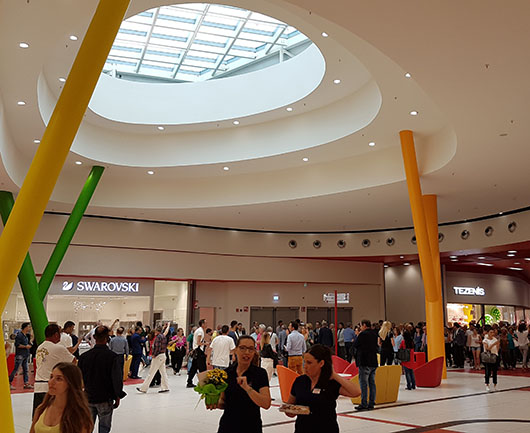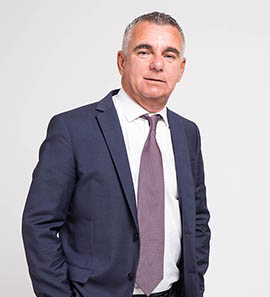A new role for shopping centers in the era of e-commerce

The expanded ESP center is emblematic of the new concept
Even though online purchases don’t carry the same weight as they do in other countries, e-commerce is profoundly changing the role of the shopping center. A role which continues to be central, as long as the property managers are willing to rethink the nature and mix of a center’s retailers. Today, this is the biggest challenge for IGD’s commercial policies. With the new ESP center in Ravenna, expanded and completely renewed, IGD has already proven that it knows how to find the right answer to the new consumption models.
We spoke about this with Daniele Cabuli, IGD’s Chief Operating Officer.
Mr. Cabuli, how are you addressing the changes brought on by the spread of e-commerce?
As always, we began by trying to understand the changes in the scenario from a theoretical standpoint, to then better define the approach to apply to our portfolio: the work done during the internal seminar in 2016 was led by Prof. Luca Pellegrini who teaches at IULM and also works with the national association of shopping centers (CNCC or Consiglio Nazionale dei Centri Commerciali). The panorama that we looked at helped us understand that the situation in Italy is very different from the United Kingdom or the United States. In Italy, the development of e-commerce is decidedly more limited. The distribution of the population, which is equally spread out throughout the country, along with relatively low density of shopping centers, protects the role of malls. The projects recently introduced in Italy, tend to confirm this: Westfield Milano, a significant example, calls for an investment of €1.4 billion to create a new destination for shopping, restaurant services and leisure time, with over 300 retailers and 50 boutiques. We are not the only ones who think that there is still ample room for the shopping center format.
In Italy this business is still valid, then. How is IGD organizing itself to better face this changing scenario?
Our belief is that the digital and physical shopping channels can live together: the two channels can coexist. The shopping center will continue to satisfy the demand for merchandise and services that cannot be purchased online: the services Click&Collect and Lockers, small closets from which purchased merchandise can be picked up at just about any time, are examples of how a purchase begun online can be completed in a physical space, in this instance the shopping center. Inversely, the space used by a certain brand in the shopping center can take on a new role as a showroom: the shopper enters, sees something of interest and makes the purchase online.
No competition, then, with online channels?
There is competition, it’s unavoidable. More competition, however, can drive a desire to do things better…. The important thing is that the competitors have the same tools. Through the sector associations we are working to get our legislator to create a fairer tax regime.
What has been your answer in terms of rethinking the shopping center concept?
For years our commercial philosophy has been based on the concept of “spaces to be lived in”. This philosophy has guided us through the years of consumer crisis and today still underlies the commitment to redefining the shopping center as a place to make purchases, meet others, try new foods, stay in shape and have a good time: a group of experiences that can’t be had online. As for the management of our assets, we first remodeled the areas, in some cases downsizing the space of the hypermarket, adding new midsize stores, including by grouping smaller stores, and, lastly, creating new spaces to be used for food courts. This is the approach to revisiting the merchandise mix.
How was the merchandising mix reorganized in this new context?
The focus on goods and services which cannot be purchased or used online has increased: this is behind the increased space dedicated to personal services, restaurants and leisure time.
Have you developed an ideal mix?
There is not one mix of the different activities that works in all shopping centers. Ours, in particular, are very different from each other in terms of configuration and location so it wouldn’t make any sense to replicate the same merchandising model everywhere.
Can shopping centers be remodeled quickly?
It’s not easy but we have already demonstrated, in several instances, that we can do it. Obviously, we always had to deal with delays linked to bureaucracy. Just think, we purchased the land for the ESP center extension in Ravenna in 2003: we succeeded in opening it this year in 14 years the world has changed continuously so we had to rethink the project many times. In the end, though, we were satisfied with the results.
Can you provide us with a bit more color as to what approach was used to complete the extension in Ravenna?
Of course. The project led us to basically double the mall’s GLA with underperforming areas inside the hypermarket. The extension provided us with a way to give ample room to restaurants, including different types, by proposing new formats. We also created an underwater theme play area for children. The doubling of the mall was also accompanied by a similar increase in the number of parking places.
What role does innovation have in these projects?
Innovation is key to the way we have responded to change. In Centro ESP, for example, we have introduced a wide range of innovations, from the “Click and Collect” service, to the totems and apps, not to mention the elements linked to sustainability like solar panels and charging stations for electric cars in the parking lots.
How are you managing the pre-existing part of the ESP mall?
The original mall underwent extensive restyling, which made it possible to adapt the design to that of the new part. In July restructuring of the Centro ESP hypermarket began: this represents one of the pilot projects that Coop Alleanza 3.0 is undertaking in order to rethink the format.
When will the work on the hypermarket be done?
The last 3,000 square meters will be done by 2 December. We will be ready, then, for the Christmas season with the best format possible in one of the region’s most important shopping centers. Since the inauguration footfalls and retailers’ sales have basically doubled. The figures for the first four months indicate that everything is going as we had assumed it would when we decided to invest the significant sum of €52 million in the project.
CENTRO ESP IN RAVENNA: KEY FIGURES

ESP shopping center in Ravenna
Year the center was built: 1998
Year in which the original mall was restyled: 2012
Inauguration of the extension: June 2017
GLA: 47 thousand m2, 18,600 of which linked to the extension
Sales area Ipercoop: 9,500 m2
New stores: 53
Midsize stores: 16
Restaurants: 11
Parking places: 3,300, 1,100 of which linked to the extension
Investment in the extension: €52 million
Share




